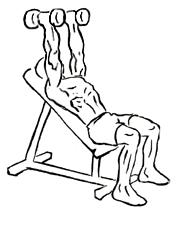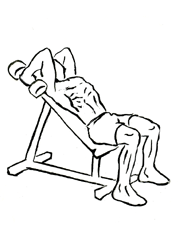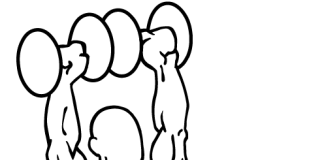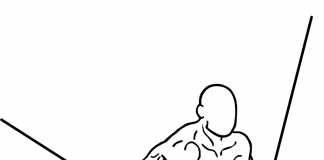Last Updated on September 25, 2014
The Incline Triceps Extensions with Dumbbell is an effective isolation exercise targeting the triceps, the large muscles located on the back of your upper arms. This exercise is perfect for building strength, improving muscle definition, and enhancing overall upper body stability. Whether you’re a fitness enthusiast looking to tone your arms or a bodybuilder aiming for mass, incorporating this movement into your workout routine can provide substantial benefits.
In this detailed guide, we’ll walk through the benefits of the Incline Triceps Extensions with Dumbbell, the proper steps to perform it, common mistakes to avoid, variations to add intensity, and tips for optimizing your workout. Let’s get started!
Benefits of Incline Triceps Extensions with Dumbbell
Before jumping into the steps, understanding why the Incline Triceps Extensions with Dumbbell is beneficial can help you appreciate its importance in your routine:
- Isolated Muscle Activation: This exercise specifically targets the triceps, allowing for maximum muscle engagement without interference from other muscle groups. Isolation exercises are crucial for muscle growth, as they focus all the tension and stress on one area.
- Enhanced Muscle Definition: Incorporating incline triceps extensions into your routine not only builds strength but also enhances muscle definition. By consistently working the triceps, you’ll achieve a sculpted, toned look over time.
- Improved Range of Motion: The incline position allows for a greater range of motion compared to flat or decline bench variations. This extended movement stretches and contracts the triceps fully, leading to increased muscle development and flexibility.
- Stability and Control: Using dumbbells adds an element of stability training as each arm works independently. This ensures that both arms develop strength evenly and helps correct any muscle imbalances.
Step-by-Step Guide to Performing the Incline Triceps Extensions with Dumbbell
Follow these steps to execute the exercise correctly and maximize your results:
1. Set Up the Equipment
- Place an incline bench at a 30-45 degree angle. Make sure the bench is stable and positioned securely before starting the exercise.
- Choose a pair of dumbbells with a weight that is challenging but allows you to maintain proper form throughout the set.
2. Get into Position
- Sit on the incline bench and lean back so that your back is fully supported.
- Plant your feet firmly on the floor to create a stable base and engage your core to maintain balance.
3. Grasp the Dumbbells
- Hold a dumbbell in each hand, using a neutral grip (palms facing each other). This grip is important as it places less stress on the elbows and allows for better muscle isolation.
- Extend your arms above your shoulders, keeping the dumbbells directly over your chest. Your arms should be fully extended but not locked to avoid undue pressure on your joints.
4. Start the Movement
- Slowly begin to lower the dumbbells by bending your elbows. Focus on keeping your upper arms stationary; only your forearms should move during the exercise.
- Lower the dumbbells behind your head, feeling a stretch in your triceps. Be careful not to go too far down to avoid unnecessary stress on your shoulder joints.
5. Pause and Lift
- Pause briefly when you reach the bottom position, ensuring that the tension remains on your triceps.
- Engage your triceps to lift the dumbbells back up in a controlled motion, returning to the starting position. Avoid locking your elbows at the top, keeping a slight bend to maintain muscle engagement.
6. Repeat
- Perform 8-12 repetitions for 3-4 sets, depending on your fitness level and goals. Ensure each repetition is done with proper form for the best results and to minimize the risk of injury.
Common Mistakes and How to Avoid Them
Like any exercise, maintaining proper form is crucial to maximizing the benefits and preventing injuries. Here are some common mistakes to watch out for and tips on how to avoid them:
- Flaring Elbows Outward
- Mistake: Allowing your elbows to flare out reduces the effectiveness of the triceps isolation and puts unnecessary strain on the shoulders.
- Solution: Keep your elbows close to your head throughout the movement. Visualize your arms as hinges—only your forearms should move.
- Arching the Back
- Mistake: Arching your back during the exercise can lead to lower back discomfort and reduced core engagement.
- Solution: Engage your core and press your lower back into the bench to stabilize your body. If you’re still experiencing strain, try using a lighter weight or adjusting the bench angle.
- Using Too Much Weight
- Mistake: Using excessively heavy dumbbells can compromise form and increase the risk of injury, especially to the shoulder and elbow joints.
- Solution: Start with lighter weights to master the technique before progressing to heavier loads. Prioritize controlled movements over lifting heavy weights.
- Dropping the Dumbbells Too Low
- Mistake: Lowering the dumbbells beyond your head’s comfort zone can place undue stress on your shoulders and limit the effectiveness of the exercise.
- Solution: Lower the weights until you feel a stretch in your triceps, but avoid going too far. Aim for a range that feels comfortable and keeps the focus on the triceps.
Variations of the Incline Triceps Extensions with Dumbbell
To keep your workouts engaging and to continue challenging your triceps, consider these variations:
- Incline Triceps Extension with a Single Dumbbell
- Instead of holding a dumbbell in each hand, use one heavier dumbbell held with both hands. This variation allows you to focus on stabilizing the weight and works as an excellent alternative for those who want to lift heavier while maintaining control.
- Alternating Arm Incline Triceps Extension
- Perform the exercise one arm at a time to increase unilateral strength and correct muscle imbalances. This variation is ideal for those looking to build balanced strength in each arm.
- Incline Triceps Extension with a Twist
- As you lift the dumbbells back to the starting position, twist your palms to face forward at the top of the movement. This small adjustment engages different parts of the triceps and adds a new challenge.
- Decline Bench Dumbbell Triceps Extension
- For a change in angle and muscle activation, try performing the exercise on a decline bench. This variation targets different fibers of the triceps and keeps your workout varied.
Tips for Maximizing Your Triceps Workout
To make the most out of the Incline Triceps Extension with Dumbbells, follow these tips:
- Warm Up Properly: Before starting any triceps exercise, spend a few minutes warming up your upper body. Dynamic stretches and light triceps-focused movements prepare your muscles and joints for the workout ahead.
- Focus on Controlled Movements: The key to effective triceps training is slow and controlled motions. Avoid swinging or rushing through the reps—each movement should be deliberate, ensuring the triceps are engaged throughout the exercise.
- Breathe Correctly: Inhale as you lower the dumbbells and exhale as you lift them back to the starting position. Proper breathing helps maintain stability and supports better muscle activation.
- Progressive Overload: To continue seeing gains, gradually increase the weight or the number of reps as you become more comfortable with the exercise. Progressive overload is essential for building muscle and improving strength.
The Incline Triceps Extensions with Dumbbell is an effective and versatile exercise that can be a valuable addition to any upper body or arm workout routine. By isolating the triceps and utilizing the incline bench position, this movement allows for greater range of motion and muscle activation, leading to improved strength and muscle definition.
Remember, consistency is key—perform the exercise with proper form, adjust the weights as needed, and explore variations to keep your routine challenging and effective. With dedication, you’ll see noticeable gains in triceps strength and overall arm development, helping you achieve your fitness goals and enhance your upper body performance.








